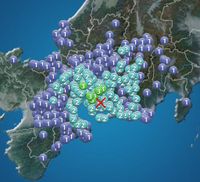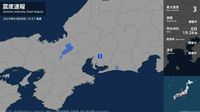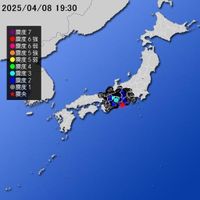On April 8, 2025, a noticeable earthquake struck western Aichi Prefecture, Japan, at 7:26 PM JST, prompting immediate reports from the Japan Meteorological Agency (JMA). The quake, which registered a magnitude of 4.6, was felt across several cities, with the strongest intensity reaching a seismic level of 3.
The epicenter of the earthquake was located in western Aichi Prefecture, specifically at coordinates 34.9 degrees North latitude and 137.1 degrees East longitude, with a depth of approximately 40 kilometers. According to the JMA, the tremors were felt most acutely in areas such as Toyota City, Tokai City, Ohbu City, and Chita City, among others.
In total, the maximum seismic intensity of 3 was recorded in the following locations: Toyota City, Tokai City, Ohbu City, Chita City, Aisai City, Aichi Miyoshi City, Togo Town, and Agui Town. Residents in these areas reported feeling the quake, but no significant damage or injuries have been reported as a result of the seismic activity.
While the earthquake's intensity was significant enough to be felt widely, there was no concern regarding a tsunami resulting from the tremor. The JMA confirmed that the geological conditions did not pose a risk of tidal waves, which often accompany undersea earthquakes.
Seismic intensity levels were also recorded in other cities across Aichi Prefecture, including Nagoya, where a lower intensity of 2 was observed in various wards, such as Chikusa, Higashi, Kita, Nishi, Nakamura, Naka, Showa, Mizuho, Atsuta, Minato, Moriyama, Midori, Meito, and Tenpaku. Additionally, areas in Okazaki City, Ichinomiya City, Seto City, and several others also experienced tremors, with intensities ranging from 1 to 2.
In neighboring prefectures, tremors were also felt. For instance, in Nagano Prefecture, cities like Iida and Nakagawa reported seismic activity, albeit at lower intensity levels. Similarly, Gifu Prefecture recorded tremors in cities such as Nakatsugawa and Gifu City. In Shizuoka Prefecture, areas including Hamamatsu and Iwata also reported feeling the earthquake.
Despite the widespread feeling of the earthquake, public transportation services, including the Tokaido Shinkansen and other train services in the region, continued to operate normally as of 7:30 PM JST, shortly after the quake occurred. The JMA and local authorities have maintained a close watch on the situation, ensuring that the public is kept informed about any aftershocks or additional seismic activity.
Earthquakes are not uncommon in Japan, a country situated along the Pacific Ring of Fire, where tectonic plate movements frequently lead to seismic events. However, this particular earthquake's magnitude and the areas affected have drawn attention due to their proximity to major urban centers.
In the aftermath of the earthquake, local governments and emergency services have been on high alert, ready to respond should any issues arise. Residents have been advised to remain vigilant and prepared for possible aftershocks, which can occur following a significant quake.
As the situation develops, the JMA continues to provide updates and safety information to the public. Citizens are encouraged to stay informed through official channels and to take necessary precautions in case of further seismic activity.
Overall, the April 8 earthquake serves as a reminder of Japan's ongoing relationship with natural disasters and the importance of preparedness in mitigating risks associated with such events. With the region's history of seismic activity, local authorities remain committed to ensuring public safety and resilience in the face of future earthquakes.







